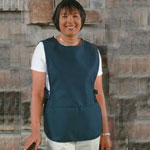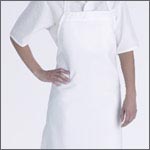The
History of Aprons
By
Thomas Morva
Aprons have been cooks’ companions for hundreds of years. Indeed,
aprons were used by men and women for a variety of tasks long before
they were seen on 1950s television. During this era, women were portrayed
as homemakers and good mothers and you rarely saw them without their
aprons.
Some researchers point to Biblical references about aprons. They cite
a passage in which Adam and Eve sewed together fig leaves to make aprons
to cover themselves.
We traditionally think of aprons being used for cooking, and while that
is true, they have served as a cover-up for other tasks that tend to
be messy. Occupations such as butchers, welders and bakers have always
used aprons to protect both their clothing
and bodies from their work.
For centuries, homemakers have used aprons. Even since the early 19th
century, women have used aprons to keep their clothing clean. They have
also used aprons to carry essential utensils such as rolling pins, for
gathering and carrying eggs and for transporting kindling wood. Aprons
have been an effective tool for many, many years.
It was not until the 1940s and 1950s that society started to see the
stereotypes of the ""perfect mother"" who always
wore an apron, no matter what. Until that time, aprons were thought
of as a functional piece of the wardrobe.
Today’s aprons are more stylish. Perhaps surprisingly, aprons
have made a fashionable comeback, even making occasional runway appearances
in the form of the apron dress.
Uniforms
USA has man aprons to choose from. Please visit our Apron
page. |
|






